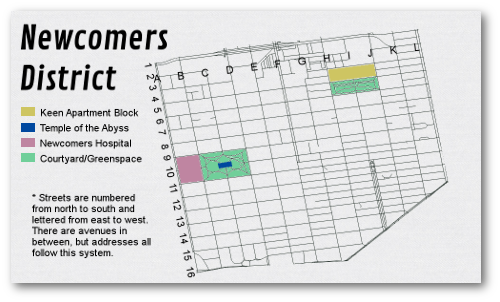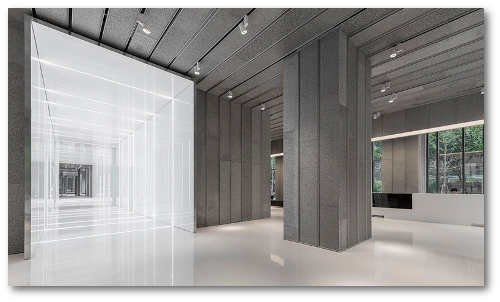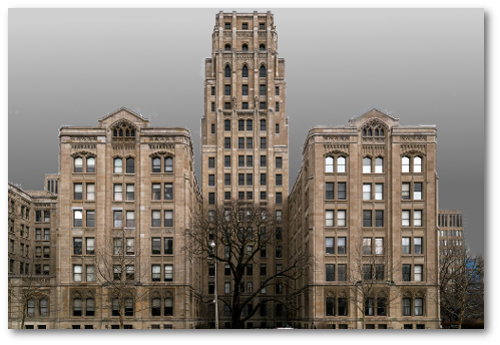entartungmods (![[personal profile]](https://www.dreamwidth.org/img/silk/identity/user.png) entartungmods) wrote2017-02-16 07:21 pm
entartungmods) wrote2017-02-16 07:21 pm
Setting Info
Entartung
Characters can learn more about the place where they have found themselves through their access to the network, or via asking after they arrive at the temple. As long as it is listed on this page, you can assume they have learned these things via their own investigation.
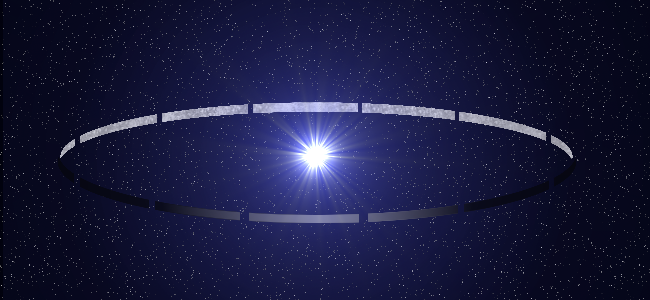
The first serious proposal of a concept that would come to be called a Dyson ring was made by a scientist from Earth, Freeman Dyson, in 1960. Such structures were an impossibility to him and his contemporaries, but this place has been constructed according to similar principles as he described. This particular ring, called Entartung, appears to have been built around a star distant from Earth.
Much of what is known about Entartung has been determined via study and observation by scientists that have come here. The history of the place before people arrived, as well as the reasons and methods of its construction, are a mystery. It is known, however, that most of the people who have arrived in the past have come from Earth. This is why the residents keep time according to a 24-hour clock. Day and night are artificial constructs of the clock, as there is no sunrise or sunset in this place. Because the ring wraps around the star, it is visible at all times directly overhead. The sky is a cold grey. Gravity on the ring is caused by its continual rotation, and a high steel security fence around its edge prevents falls. The ring consists of twelve segments that orbit around the local star, Leben, which is a white dwarf. White dwarf stars are short-lived, so it would have been unlikely for this star to host a planet where life evolved on its own. However, being small and bright, it appears this star was deemed suitable to be the place that would host life on Entartung.
The ring itself is made from a slag-like material and covered with a thick layer of grit. Builders don’t need to dig far to get to foundation level (about 8 feet).
As far as the scientists who work and study here have been able to determine, only one segment is populated—the segment that hosts the city of Centre.

The first serious proposal of a concept that would come to be called a Dyson ring was made by a scientist from Earth, Freeman Dyson, in 1960. Such structures were an impossibility to him and his contemporaries, but this place has been constructed according to similar principles as he described. This particular ring, called Entartung, appears to have been built around a star distant from Earth.
Much of what is known about Entartung has been determined via study and observation by scientists that have come here. The history of the place before people arrived, as well as the reasons and methods of its construction, are a mystery. It is known, however, that most of the people who have arrived in the past have come from Earth. This is why the residents keep time according to a 24-hour clock. Day and night are artificial constructs of the clock, as there is no sunrise or sunset in this place. Because the ring wraps around the star, it is visible at all times directly overhead. The sky is a cold grey. Gravity on the ring is caused by its continual rotation, and a high steel security fence around its edge prevents falls. The ring consists of twelve segments that orbit around the local star, Leben, which is a white dwarf. White dwarf stars are short-lived, so it would have been unlikely for this star to host a planet where life evolved on its own. However, being small and bright, it appears this star was deemed suitable to be the place that would host life on Entartung.
The ring itself is made from a slag-like material and covered with a thick layer of grit. Builders don’t need to dig far to get to foundation level (about 8 feet).
As far as the scientists who work and study here have been able to determine, only one segment is populated—the segment that hosts the city of Centre.
Centre

The city of Centre is capable of hosting a population of about half a million, but currently only about 350,000 citizens live there. It contains a large variety of zoned buildings:
- Medical facilities
- Science & research facilities
- Dinner theaters, cinemas, and entertainment districts
- Apartment blocks, which include amenities such as salons and restaurants
- Trolley & train stations
- Airship docks
- Refuse incinerators
- Solar collectors
- Water reclaiming stations
The city is built compactly in an area of 47 square miles (124 square kilometers) and includes little greenspace. The region around the city is arid—beyond the bounds of the infrastructure that lies outside the city, it appears to be desert. The city is situated somewhat close to one edge of the segment, allowing people to view the high steel security fence that borders the segment to prevent people from falling off the ring.
There are no bodies of water in or near Centre. Water is supplied via the environmental scrubbers and an elaborate plumbing system. Similarly, there are no forests in Centre. There are isolated trees in the city, but no large parks that lend themselves to having groupings of trees. Instead, every patch of bare soil is used to grow produce for consumption. Although the replicators are capable of providing all the food a person could need, the taste and texture of all the food created by them is a bit mealy, and this can be offset by preparing the food with fresh fruits and vegetables included.
Newcomers District
All citizens first arrive in the Newcomers district of the city, where living quarters and services are free to the residents. Residents of the Newcomers district live free of charge as long as they remain in the district. Shops and replimats (restaurants where replicators supply the food) are common in the area.
Several key locations cater to the needs and interests of the people who call this district home.The Temple of the Abyss
Many years ago, when citizens were first brought to Entartung, the location of their appearances was observed and this building was erected to shelter those occurrences. The process that brings people here seems to disorient them greatly, so they are unable to assent to have their SYNC chip installed. However, it is taken for granted that the person has already agreed to this when they went through the process that leads to them being brought here.
There is some religious sentiment toward the force that has brought people here. The Nachdruck seem to draw those who would be inclined to be disobedient to their desires to the Temple, tempting them to come and commune in worship with them. Supplicants can enter the Temple and bridge their network chip directly to the Temple's systems, with the help of the Temple's priestess, and those who chose to do so will experience extreme calm and contentment. This is a deliberate decision on the part of the faithful, who may find that the Nachdruck also take their desires to return home and to rebel from them during the process. Tokens, such as items from home that people arrived with in their pockets, may also be thrown on the altar to help achieve this affect.
After some time, the ring itself became a symbol of their beliefs—carried with them regularly as a facsimile on the finger or worn on a string or chain around the neck. It permeates the society that lives upon it, frequently seen in materials that emphasize the harmony of its inhabitants.
In addition to the above, the Temple is the site of a curious phenomenon, known as Revival. Occasionally, for unknown reasons, residents of the city will disappear, only to arrive here five days later with additional memories of their time in their old life. It’s unknown what the mechanism behind this is, but the devout will sometimes arrive here on a mission to manufacture this spiritual awakening for themselves.Newcomers Hospital
Right next door to the Temple of the Abyss is Newcomers Hospital, which is in close proximity to the temple in case anyone who arrives needs rapid medical care. It is typical of the medical facilities available in Centre. Technology in Centre is such that most any ailment or injury can be treated, including replicated body parts for amputees.
Citizens also visit the hospital to have their SYNC software updated or changed. Special doctors, known as SYNC specialists, service the chips and adjust the software, as necessary. The user can have additional software programmed to be installed. This additional software can provide expertise in a new field of knowledge, such as medicine, astronomy, languages, higher math, etc. But there is only so much room for new software and only one such package can be installed. Like augmentation of body parts, this procedure may be costly to the user.The Keen Apartment Block
The Keen building consists of a tower and two wings. Each section of the building contains studio apartments on the lower floors, with larger apartments as one rises in the building. The top of the tower contains two two-story penthouse apartments. This is the main location for housing for newcomers to the city. However, there are many style of residence in the Newcomers district, all of which are free for new arrivals to live in.
The first floor of Keen hosts a number of businesses, some of them owned by the recent arrivals, and include a salon, a replimat diner, a laundromat, and a bar.Other Living Quarters
Other residences are available in the Newcomers district for newcomers, and remaining in this district allows characters to live rent-free. They range from apartments to condos, duplexes, and houses, but living outside of the district will incur costs. Streets in the Newcomers district are numbered from north to south, and lettered from east to west. The closer the house is to the train line (at the southeast), the larger the house may tend to be.
The Institute

The Institute is the foremost research facility in the city of Centre. Though on Earth this function is typically carried out by universities, on Entartung it’s possible to have knowledge programmed into one’s SYNC chip. However, there is still much to learn about the universe, and scientists work diligently here to make discoveries to be added to the knowledge banks of the citizens here.
In addition to research in the fields of physics, chemistry, and mathematics, researchers here make advances in the fields of sociology, psychology, and other fields.
Entertainment
There’s a thriving entertainment industry in Centre, though because of its scale only one new movie release takes place at a time. Still, the cinemas often show second-run movies to supplement the current runs of films.

Cabaret style night clubs are all the rage here, affording customers with dinner and a show for a set price.

Along with the other options for entertainment, citizens may have their latest art pieces put on display in the art gallery. Much of the art here is digital and is projected on a screen, or consists of sculptures, because there is not much paper here.
Travel
The city is devoid of motorized automobiles, leaving people to either travel by bicycle or use the trolleys. There is also a track for a commuter train, which travels from one corner of the city to the other.
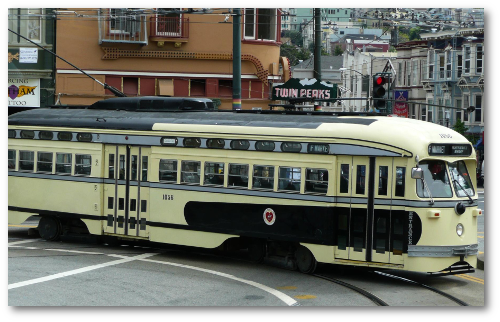
Lastly, if one wishes to travel in more luxury for a steeper fee, there are the airships, which also deliver workmen from the city to more distant destinations dealing with infrastructure in the power grid and atmospheric systems.

Infrastructure
Supporting a population takes a lot of coordination, and a number of different types of facilities handle these functions. Scattered throughout the city and on rooftops are the power collectors, which collectively spread over hundreds of kilometers, soaking in the rays of the local star to deliver electricity to the citizens of the city itself. Water collectors at the edges and corners of the ring segment form an artificial atmosphere and collect water from the air for use in the city. And within the city itself are specialized refuse incinerators, water recycling plants, and waste collection depots. Everything is run as efficiently as possible, so as to avoid cluttering the city or poisoning its citizens.
Economy
Centre has a participatory economic system, in which the people mutually agree what roles deserve better pay and benefits, how much should be produced, and so forth. There is a spectrum of different classes, which are divided on different lines from what we may be used to in a capitalist society. For example, laborers are paid more than office workers, because of the danger and difficulty of their jobs.
The richest people in town can afford places such as the penthouse apartments in the Keen apartment block, but there is no one who is flamboyantly, obnoxiously wealthy. These comprise about 7% of the population. Meanwhile, people who live below the poverty line are usually people who are prevented from working for reasons of disability or mental illness, or who don’t work out of laziness or other reasons. There are social safety nets for those people, but inevitably there are people who fall through the cracks. These comprise about 10% of the population.
Money is measured in tokens, where about 100 tokens: 1 modern US dollar. Therefore a coffee at a cheap cafe costs about 100 tokens.The average income is lower than might be expected, since rent is low (free, for those who remain in their provided studio apartments) and meals are provided. Therefore, the average income is about 2.5 million tokens, which is about equivalent to making $25,000 in the modern US. Currency is digital. It is unknown whether it is backed by anything.
There is relatively little scarcity. The larger the item, though, the less likely it is that the city's manufacturers be able to create it from parts from the replicator, which is why there are trolleys, trains, and airships, but no cars. It’s not worth the expense to make something that big for a single individual.
| Read More | |||
| Premise | Welcome | Network | Rules & FAQ |
| Full Navigation | |||
Revision: 3.2 Revised: 4.26.2018


